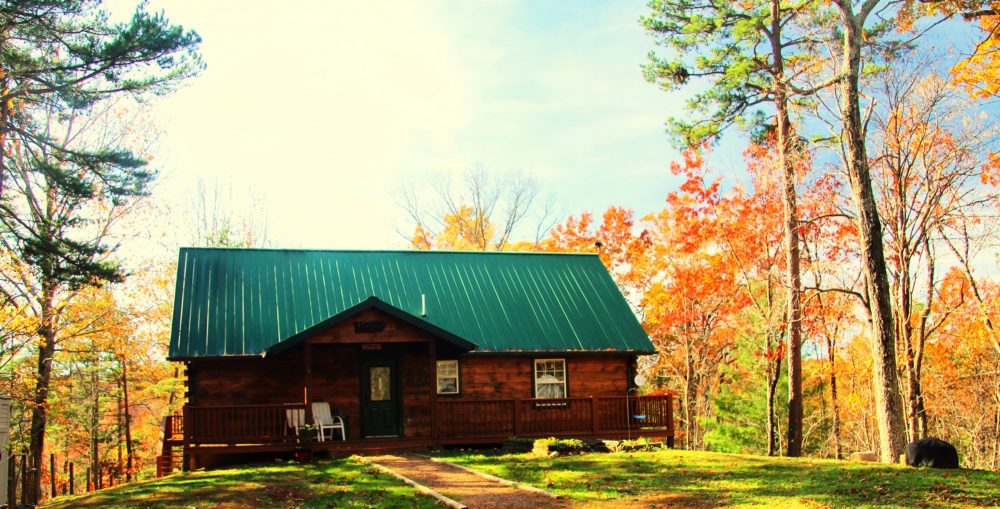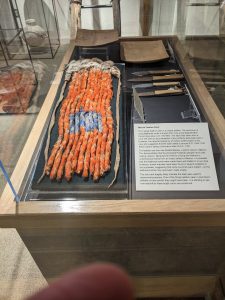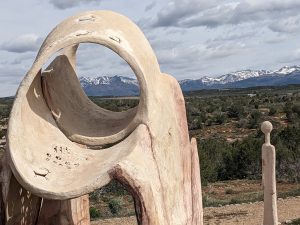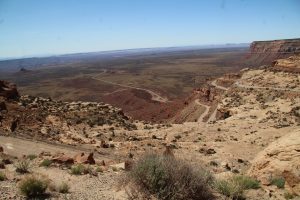We are here to check Aztec 
 Ruins National Monument. Museum displays compare and contrast the Pueblo and Chaco civilizations through their pottery, architecture, and building techniques plus try to connect the dots between those populations and the many native tribes that have and still do occupy these lands.
Ruins National Monument. Museum displays compare and contrast the Pueblo and Chaco civilizations through their pottery, architecture, and building techniques plus try to connect the dots between those populations and the many native tribes that have and still do occupy these lands.
The grounds protect a huge Pueblo settlement of which about half has been excavated. Weather has taken its toll but enough remains to give a good idea of how it looked as-built. A trail allows us to wander through the many rooms of this huge structure. It is amazing. The great Kiva has been rebuilt based on archeologic evidence. There is still debate about exactly what the Kivas were used for but whatever that outcome, this structure is impressive.
Another cool feature, two green stripes of stone are built into the entire length of one exterior wall. This feature has not been seen in any other ruins, Chaco or Pueblo, in the entire four corners area. Cool. What’s that about?

 complete reconstruction of the 1880 settlement. Descendants have contributed items from the actual period and tell the stories of hardship and determination in the words as passed down through their families. One can visit other sites along the Hole-in-the rock Trail. They are very remote in rugged country. We’ll settle for this insight into the journey.
complete reconstruction of the 1880 settlement. Descendants have contributed items from the actual period and tell the stories of hardship and determination in the words as passed down through their families. One can visit other sites along the Hole-in-the rock Trail. They are very remote in rugged country. We’ll settle for this insight into the journey. River is a huge petroglyph panel. Hundreds of figures cover the heavily patinaed sections of the cliffs along the river flood plain. It is inside Sand Island campground in an area that sees lots of foot traffic. There has been some vandalism but a great number of the figures are still visible. We are on a scavenger hunt for a Columbian mammoth with a bison figure overlaid. It is highlighted at the Education Center as it dates the site to over 13,000 years ago. We didn’t find it but still, a fun and amazing stop. I wonder what the original authors are thinking as they hear us speculate as to the intent of these writings.
River is a huge petroglyph panel. Hundreds of figures cover the heavily patinaed sections of the cliffs along the river flood plain. It is inside Sand Island campground in an area that sees lots of foot traffic. There has been some vandalism but a great number of the figures are still visible. We are on a scavenger hunt for a Columbian mammoth with a bison figure overlaid. It is highlighted at the Education Center as it dates the site to over 13,000 years ago. We didn’t find it but still, a fun and amazing stop. I wonder what the original authors are thinking as they hear us speculate as to the intent of these writings.

 The road is not as bad as many reviews declared but not great either. Kent makes it around in 2-wheel drive, so not too bad. Prominent buttes are named, some easily identified like “the mittens” others like “the elephant” require a bit more imagination and a view from just the right angle. It is cool to wind our way among them as shadows change with the rising sun angle. My favorite is probably the totem pole and adjacent dancers, The Yei Bi Chei. We leave with a lot of pictures! I am not certain which drive is the more impressive, Monument Valley or Valley of the Gods. Monument Valley is immense and the raw scale as we move through it makes one feel small in comparison. The drive through the narrower Valley of the Gods brings us closer to the features making it seem like a more personal experience. Both could be improved by removing distracting human intrusions: boondocking RVs all over Valley of the Gods and rooftops of homesteads among the buttes of the Tribal Park. Both have tipped too far in the scale balancing right-to-use and preservation, in my opinion. But yes, I too would have loved to have spent a silent night under a star-filled sky in Valley of the Gods.
The road is not as bad as many reviews declared but not great either. Kent makes it around in 2-wheel drive, so not too bad. Prominent buttes are named, some easily identified like “the mittens” others like “the elephant” require a bit more imagination and a view from just the right angle. It is cool to wind our way among them as shadows change with the rising sun angle. My favorite is probably the totem pole and adjacent dancers, The Yei Bi Chei. We leave with a lot of pictures! I am not certain which drive is the more impressive, Monument Valley or Valley of the Gods. Monument Valley is immense and the raw scale as we move through it makes one feel small in comparison. The drive through the narrower Valley of the Gods brings us closer to the features making it seem like a more personal experience. Both could be improved by removing distracting human intrusions: boondocking RVs all over Valley of the Gods and rooftops of homesteads among the buttes of the Tribal Park. Both have tipped too far in the scale balancing right-to-use and preservation, in my opinion. But yes, I too would have loved to have spent a silent night under a star-filled sky in Valley of the Gods. namesake, Bears Ears Buttes. We are out along Colorado 95 checking out Puebloan ruins and get a pretty good outline on the horizon.
namesake, Bears Ears Buttes. We are out along Colorado 95 checking out Puebloan ruins and get a pretty good outline on the horizon.

 Stuff I didn’t know or never saw: stone arrowheads on a yucca strand to be carried like an ammo cartridge, a chart comparing the eras of world civilizations – the Anasazi span is remarkable, a sculpture demonstrating the use of shadow and sun-light beams for telling seasons and “time”. We have made our way through a number of museums housing similar artifacts. It is fantastic to come across something new. There is a partially excavated and restored Pueblo Village on the ground. We explore including checking out the inside of the Kiva. Edge of Cedars is definitely worth a stop.
Stuff I didn’t know or never saw: stone arrowheads on a yucca strand to be carried like an ammo cartridge, a chart comparing the eras of world civilizations – the Anasazi span is remarkable, a sculpture demonstrating the use of shadow and sun-light beams for telling seasons and “time”. We have made our way through a number of museums housing similar artifacts. It is fantastic to come across something new. There is a partially excavated and restored Pueblo Village on the ground. We explore including checking out the inside of the Kiva. Edge of Cedars is definitely worth a stop.

 . We start with Valley of the Gods, a smaller scale Monument Valley. 17 miles of narrow gravel road wind through a field of redrock formations. Shadows and colors are beautiful in the morning light.
. We start with Valley of the Gods, a smaller scale Monument Valley. 17 miles of narrow gravel road wind through a field of redrock formations. Shadows and colors are beautiful in the morning light.

 Utah starts off through a wide valley of rolling desert scrub. By mid-way through the trip, red sandstone formations begin to appear on the landscape. As we move on, gigantic monoliths and delicate spires become more and more common. Soon we find ourselves in the middle of Monument Valley. It is awesome. We have to stop at Forest Gump Point for a quick selfie of course then its on to Hat Rock near the town of Mexican Hat and finally our new home. We are at Cottonwood RV in Bluff for next few days.
Utah starts off through a wide valley of rolling desert scrub. By mid-way through the trip, red sandstone formations begin to appear on the landscape. As we move on, gigantic monoliths and delicate spires become more and more common. Soon we find ourselves in the middle of Monument Valley. It is awesome. We have to stop at Forest Gump Point for a quick selfie of course then its on to Hat Rock near the town of Mexican Hat and finally our new home. We are at Cottonwood RV in Bluff for next few days.

 bed of Wahweap Creek is a collection of cool looking, odd shaped, gravity defying towers. Dakota Sandstone caps sit atop towers of Entrada Sandstone that the powers of wind and water have carved free from surrounding cliffs. Around the spires are mounds that resemble melted candles and recesses filled with intricate shapes and curtains created as waters recede and evaporate redepositing rock. At our feet in the flow channels of the creek-bed, the last vestiges of floodwaters have carved what looks like miniature versions of the canyon features all around us.
bed of Wahweap Creek is a collection of cool looking, odd shaped, gravity defying towers. Dakota Sandstone caps sit atop towers of Entrada Sandstone that the powers of wind and water have carved free from surrounding cliffs. Around the spires are mounds that resemble melted candles and recesses filled with intricate shapes and curtains created as waters recede and evaporate redepositing rock. At our feet in the flow channels of the creek-bed, the last vestiges of floodwaters have carved what looks like miniature versions of the canyon features all around us.